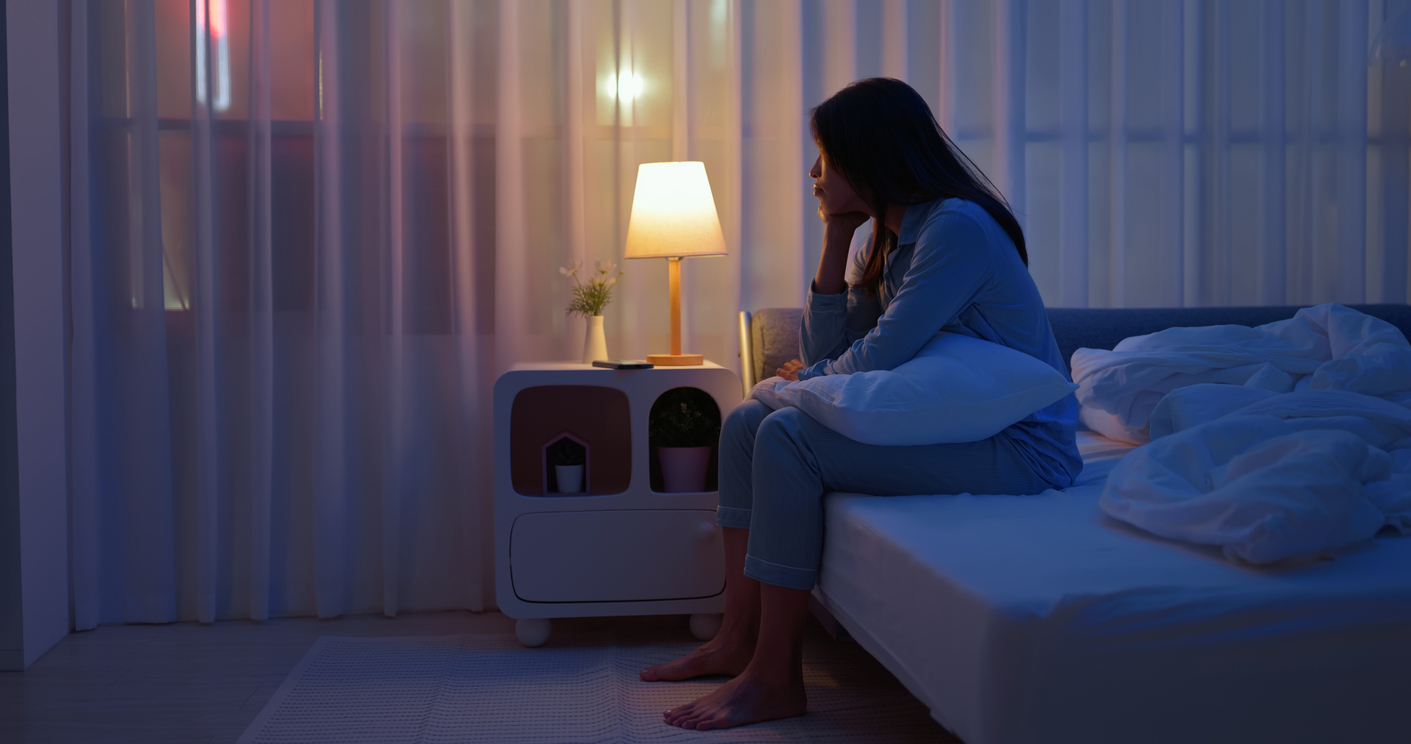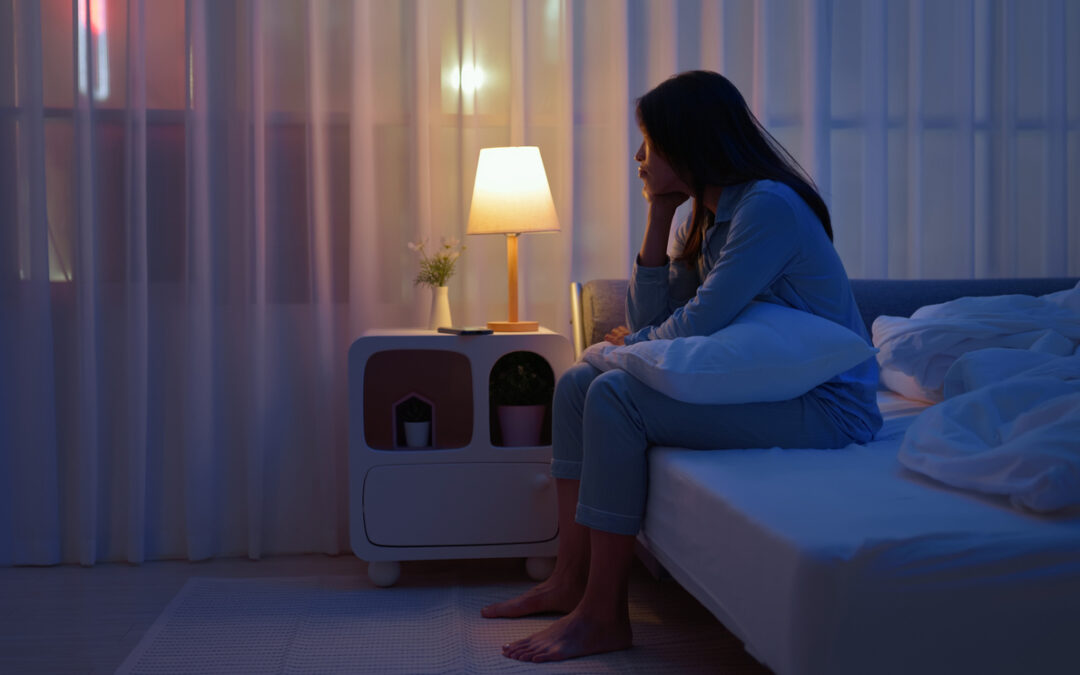
PhotoCredit_PonyWang_iStock
Many people find themselves lying awake for long stretches, wondering why sleep seems so elusive. It can take longer to fall asleep due to factors like poor sleep habits, an irregular sleep schedule, stress, certain medical conditions, or misalignment with the body’s natural sleep rhythm. We’ll take you through the checklist of common causes and suggest clinically proven sleep aids that can help get your sleep patterns back on track.
Common Causes of Difficulty Falling Asleep
Several factors can interfere with the ability to fall asleep quickly. These typically include emotional concerns, daily habits that disrupt sleep, and inconsistent bedtimes.
Stress and Anxiety
Stress prompts the body to release hormones like cortisol and adrenaline, increasing alertness and making it harder to relax at night. Everyday challenges—such as work pressure, financial worries, or family concerns—often keep the mind active long after going to bed.
Anxiety disorders can further intensify these symptoms by causing persistent racing thoughts or repetitive worries. Many people find themselves “clock watching” or becoming frustrated about not being able to fall asleep, which only highlights the problem and creates a cycle of sleeplessness.
Physical symptoms linked to anxiety, such as an increased heart rate or muscle tension, may also prevent the body from fully winding down. Practicing stress reduction techniques, such as deep breathing or mindfulness, may help counteract some of these effects.
Poor Sleep Hygiene
Sleep hygiene refers to the habits and environmental factors that impact sleep quality. Drinking caffeine or consuming large meals too late in the evening can interrupt the body’s ability to initiate sleep. Using electronic devices close to bedtime exposes the brain to blue light, which suppresses melatonin production and delays sleep onset.
Irregular bedtimes, engaging in stimulating activities before bed, or having a bedroom environment that is too bright, noisy, or warm can all contribute to poor sleep hygiene. A cluttered sleep environment may also act as a visual or mental stimulus, making relaxation more difficult.
Establishing a calming nighttime routine—such as dimming lights, reading, or listening to soft music—can help signal to the body that it is time to rest. Making the sleep area comfortable and reserving the bed for sleep can strengthen the mental association between the bed and falling asleep.
Irregular Sleep Schedules
A person’s internal clock, or circadian rhythm, controls natural sleep and wake cycles. Going to bed and waking up at different times each day can disrupt this natural rhythm, making it difficult to fall asleep consistently. People who work shifts or travel frequently may notice this effect most strongly.
Inconsistent schedules can lead to “social jetlag,” where the body’s sleep-wake cycle is misaligned with actual activities. This can cause difficulty falling asleep, poor sleep quality, and increased fatigue during the day.
Maintaining consistent sleep and wake times—even on weekends—helps stabilize the circadian rhythm. Using cues like exposure to natural light in the morning and limiting naps late in the day can also help align the body’s clock with a regular bedtime.
Sleep Aid MDsleep +hemp Summary
Sleep aids can be used to re-establish your sleep rhythm, but not all sleep aids are clinically proven. MDsleep + Hemp is a clinically-proven sleep supplement designed to help users achieve a deep, restorative sleep. The product is formulated with a blend of natural ingredients including full spectrum hemp, GABA, L-Theanine, and various botanicals. It is non-psychoactive, melatonin-free, and works by calming the central nervous system, reducing stress and anxiety, and promoting relaxation.
Benefits of MDsleep + Hemp
|
Key Benefits of MDsleep + Hemp |
|
|
|
|
|
Physical and Medical Factors
Several physical or medical conditions can make it harder for someone to fall asleep. These challenges often disrupt the body’s natural sleep signals, causing delays in falling asleep or making it difficult to stay asleep.
Chronic Pain
Chronic pain from conditions like arthritis, fibromyalgia, migraines, or back injuries often leads to difficulty falling asleep. Persistent discomfort or pain at night can make it almost impossible to find a comfortable position.
Pain signals are more noticeable in the quiet and dark of night, which can increase a person’s awareness of their symptoms. This can trigger frequent shifting in bed and can delay the transition from wakefulness to sleep.
Some people with chronic pain experience periodic flare-ups that further disrupt their sleep patterns. Addressing pain with appropriate treatments or physical therapy can sometimes help improve sleep onset and minimize nighttime awakenings.
Medication Side Effects
Many prescription and over-the-counter medications can interfere with the ability to fall asleep. Common culprits include certain antidepressants, steroids, stimulants, decongestants, and even some blood pressure drugs.
Some medications contain ingredients that increase alertness or raise heart rate, making it harder for the body to enter a restful state. Others can cause jitteriness or restlessness as side effects.
It is important for individuals to review any medications they are taking with their healthcare provider. Adjustments in dosage or timing, or switching to an alternative medication, may help if insomnia is linked to side effects.
Sleep Disorders
Sleep disorders such as insomnia and obstructive sleep apnea can be primary causes of prolonged sleep latency. Insomnia, for example, is characterized by an ongoing difficulty falling asleep or staying asleep, often tied to stress, anxiety, or medical conditions.
Sleep apnea involves repeated stoppages in breathing that fragment sleep, often causing those affected to awaken multiple times without realizing it. Restless legs syndrome is another disorder that can create uncomfortable sensations at night, leading to frequent movement and delayed sleep.
These conditions often require targeted treatment, such as cognitive-behavioral therapy for insomnia or continuous positive airway pressure (CPAP) therapy for sleep apnea. Left untreated, sleep disorders can have significant impacts on both health and daily functioning.
Lifestyle Influences on Falling Asleep
Personal habits and daily choices can have a direct impact on how quickly a person falls asleep. The timing and nature of evening activities, food, and drink can interfere with the body’s ability to wind down.
Evening Screen Time
Exposure to the blue light emitted from phones, tablets, and computers in the evening suppresses the production of melatonin, the hormone that regulates sleep. This artificial light tricks the brain into thinking it is still daytime, which delays the body’s natural readiness for sleep.
Many people use electronic devices close to bedtime, but this habit has been linked to longer sleep onset and poorer sleep quality. Notifications and stimulating content can also keep the mind alert, making it harder to relax.
Practical tips:
- Limit screen use 1-2 hours before bed.
- Enable “night mode” or blue light filters if screens must be used.
- Swap screens for calming activities such as reading or listening to music.
Caffeine and Stimulants
Caffeine is a well-known stimulant that can persist in the body for 6 to 8 hours, which means an afternoon coffee or energy drink may interfere with falling asleep at night. Besides coffee, caffeine is present in tea, chocolate, some sodas, and over-the-counter medications.
Nicotine and certain decongestants are other stimulants that can keep a person awake. Even small amounts can make a difference for people who are sensitive.
Key considerations:
|
Substance |
Duration of Effects |
Common Sources |
|
Caffeine |
6-8 hours |
Coffee, Tea, Soda |
|
Nicotine |
1-2 hours |
Cigarettes, Vapes |
|
Decongestants |
4-6 hours |
Cold Medicines |
Avoiding these substances in the late afternoon and evening is recommended for better sleep onset.
Dietary Habits
Eating large meals late in the evening can make falling asleep more difficult because digestion stimulates the body, especially if foods are rich in fats or spices. Certain foods and drinks, such as those high in sugar, can also cause fluctuations in blood sugar that disturb the process of going to sleep.
Alcohol may initially cause drowsiness, but it disrupts the sleep cycle and can result in fragmented sleep or early awakenings. Staying hydrated is important, but consuming large amounts of fluids close to bedtime may increase nighttime awakenings due to the need to urinate.
Tips for better sleep:
- Finish large or heavy meals at least 2-3 hours before bed.
- Limit spicy or sugary snacks in the evening.
- Opt for lighter foods if hungry late at night, such as yogurt or a small banana.
Shop MDsleep
Find sleep aids that were designed by doctors and validated by research.
Environmental Conditions Affecting Sleep Onset
Various environmental conditions in the bedroom can slow how fast a person falls asleep. Light, noise, and room temperature all play significant roles by interfering with the body’s ability to transition to sleep.
Bedroom Lighting
Light exposure before and during bedtime influences the body’s production of melatonin, the hormone that signals it is time to sleep.
Bright room lighting, the blue light from electronic devices, or streetlights shining through windows can all delay sleep onset. This is because light exposure, especially in the blue spectrum, suppresses melatonin and disrupts circadian rhythms.
Dim, warm-toned lighting creates a more sleep-friendly environment. Blackout curtains, eye masks, and minimizing screen time for at least an hour before bed can help. Some people use smart bulbs or dimmable lights that reduce intensity in the evening to encourage the body’s natural sleep cues.
Noise Levels
Even low-level background noise can affect how long it takes to fall asleep. Sudden or inconsistent sounds—like city traffic, pets, or household appliances—may cause micro-awakenings or prevent the brain from reaching the relaxed state needed for sleep.
Continuous noise can be disruptive, but steady, predictable sounds such as white noise or soft background music can mask disturbances. Using earplugs, noise-cancelling devices, or white noise machines may reduce the impact of environmental sounds.
Soundproofing elements, such as heavy curtains or rugs, are practical for minimizing outside noises. Those living in busy areas may benefit most from these approaches.
Room Temperature
Temperature directly affects sleep onset by influencing the body’s internal thermostat. Most adults fall asleep fastest in room temperatures between 60 and 67°F (15 to 19°C).
Rooms that are too warm or cold make it difficult for the body to lower its core temperature, which is necessary for falling asleep. Overly hot environments can lead to restlessness and sweating, while cold rooms may cause shivering.
Adjusting bedding, using fans, or setting a thermostat to a comfortable range can improve sleep onset. Lightweight, breathable fabrics and seasonal bedding swaps help maintain an optimal sleeping environment.
When to Seek Professional Help
Sometimes, sleep difficulties are temporary and resolve with lifestyle changes. However, persistent problems falling asleep may signal a more serious issue.
People should consider consulting a healthcare professional if they:
- Take longer than 30 minutes to fall asleep most nights
- Struggle with sleep despite good sleep hygiene
- Feel excessively tired during the day
- Experience stress, anxiety, or low mood linked to poor sleep
Table: Indicators for Seeking Help
|
Symptom |
Possible Concern |
|
Trouble falling asleep nightly |
Insomnia or circadian disorder |
|
Falling asleep too quickly |
Sleep deprivation |
|
Daytime sleepiness |
Underlying medical issue |
|
Mood changes |
Mental health concern |
It’s important not to ignore ongoing sleep disturbances. Long-term issues may affect mental and physical health.
A doctor may ask about sleep patterns, daily routines, and mental health. They might recommend sleep studies or specific treatments based on symptoms.
Prompt attention to sleep difficulties can prevent complications. Professional guidance ensures that any underlying problems—such as insomnia, circadian rhythm disorders, or other medical conditions—are addressed appropriately.
Frequently Asked Questions
Sleep onset can be influenced by lifestyle, environment, and physiological factors. Understanding normal versus abnormal patterns may help in identifying when a problem exists and what steps to try for improvement.
What factors contribute to difficulty falling asleep even when feeling exhausted?
Difficulty sleeping despite tiredness may result from high stress, inconsistent sleep schedules, caffeine intake, hidden medical conditions, or poor sleep hygiene. Anxiety and overstimulation before bed can also prevent relaxation needed for sleep. Certain sleep disorders, such as insomnia, may interfere even when fatigue is present.
How long is considered abnormal for falling asleep and might indicate insomnia?
Most people fall asleep within 10 to 20 minutes of lying down. Taking more than 30 minutes to fall asleep on a regular basis may indicate insomnia or another sleep disorder. Consistent trouble initiating sleep can warrant further evaluation by a healthcare provider.
What are effective techniques for falling asleep more quickly?
Maintaining a consistent bedtime schedule and limiting caffeine and alcohol intake can improve sleep onset. Creating a relaxing pre-bedtime routine, minimizing noise and light, and keeping the bedroom cool and comfortable are also helpful. Regular physical activity and limiting late-day naps can support better sleep at night.
Is it normal to take multiple hours to fall asleep, and what could this mean?
Taking hours to fall asleep is not typical and may signal chronic insomnia or underlying medical or psychological issues. Persistent difficulty may require assessment for conditions such as anxiety, depression, or circadian rhythm disorders. If this occurs frequently, seeking professional advice is recommended.
What impact does screen time before bed have on sleep latency?
Exposure to screens before bed, such as phones, computers, or televisions, can delay sleep onset by suppressing melatonin production. The blue light emitted from screens interferes with the body’s natural cues for sleep. Reducing screen time at least 30 to 60 minutes before bed may help improve the ability to fall asleep.
What is the scientifically suggested average time for a person to fall asleep?
The average healthy adult usually falls asleep within 10–20 minutes after going to bed. Times shorter than this can indicate sleep deprivation, while longer durations may suggest an underlying sleep difficulty or lifestyle factor affecting sleep latency.
text answer
Read Next:
Text

Kia Michel, MD
Physician
Kia Michel, MD is an urologist and staff surgeon at Cedars-Sanai Medical Center in Los Angeles. As a founding member of Comprehensive Urology in Beverly Hills, he believes in treating all aspects of a patient’s wellbeing in order to achieve optimal health. After 25 years in private practice, Dr. Michel believes that a good night’s sleep is essential to maintaining your health, which inspired him to co-create the MDsleep community and the Sleep Doctors Blog.
What Our Readers Say
“Thanks to the insightful articles, I’ve finally managed to get back to my old sleep routine. I feel more rested and energetic each day!”
“The blog’s advice on sleep hygiene has been a game-changer for me. I never realized how small changes could make such a big difference.”
“I struggled with insomnia for years, but the tips I found here have helped me sleep through the night consistently. Thank you!”
“I no longer feel like a zombie from The Walking Dead series! I finally have my life back.”
Follow Us for More Sleep Insights
Discover Better Sleep Solutions
Unlock the secrets to a restful night by exploring our expert-backed articles and join our vibrant community for personalized sleep tips.
List of References
- AASM Sleep Prioritization Survey: This survey by the American Academy of Sleep Medicine examines the use of melatonin among the public. It reveals trends and insights into how melatonin influences sleep patterns. For more information, visit AASM Sleep Prioritization Survey, Melatonin Use.
- Melatonin Overview: The A.D.A.M. Medical Encyclopedia provides a detailed entry on melatonin, discussing its role as a natural hormone and its applications in treating sleep disorders. More details can be found at Melatonin – MedlinePlus.
- Cannabinoids and Sleep: A study by Kaul, Zee, and Sahni reviews the effects of cannabinoids on sleep and their potential therapeutic roles in managing sleep disorders. This research can be accessed through Neurotherapeutics.


